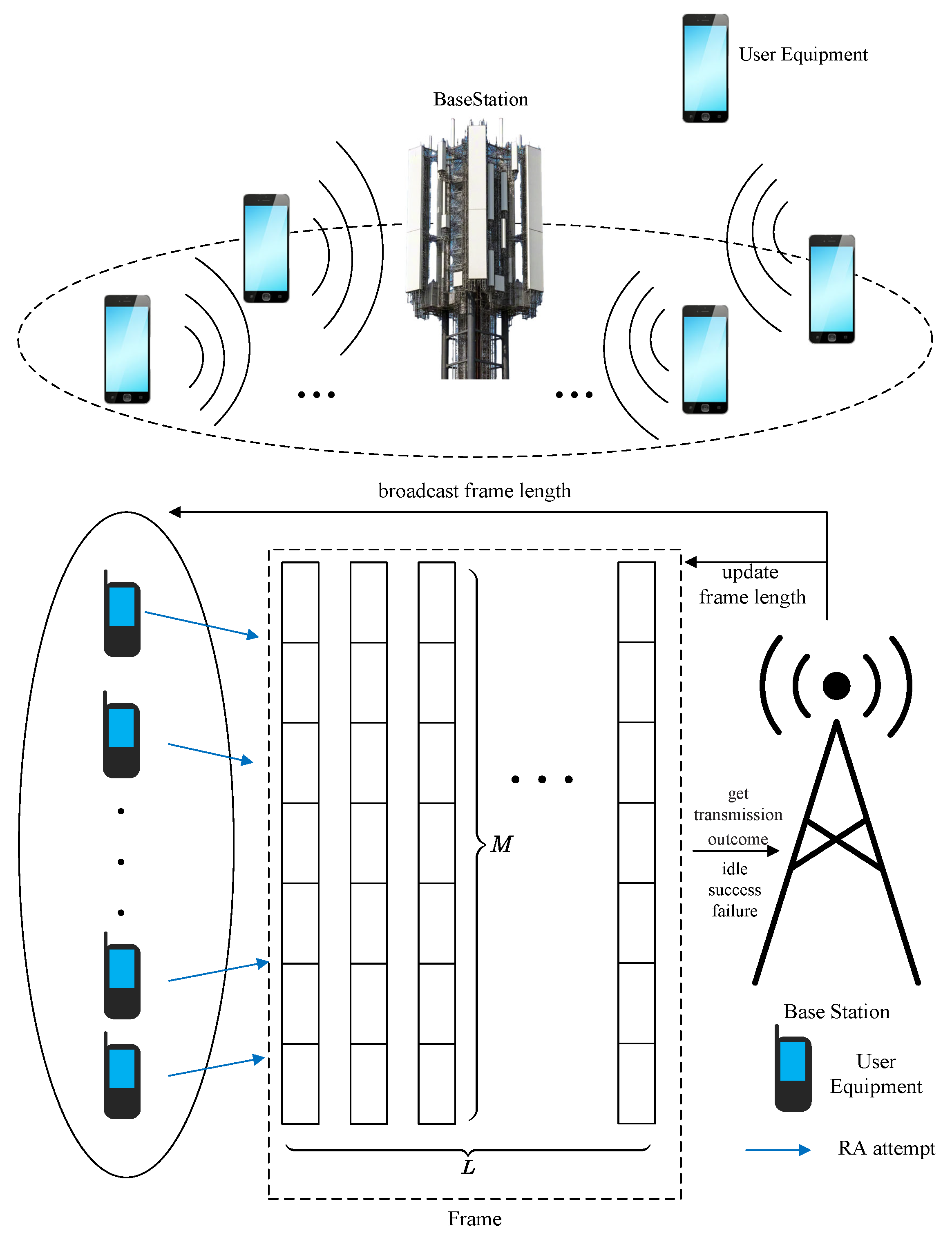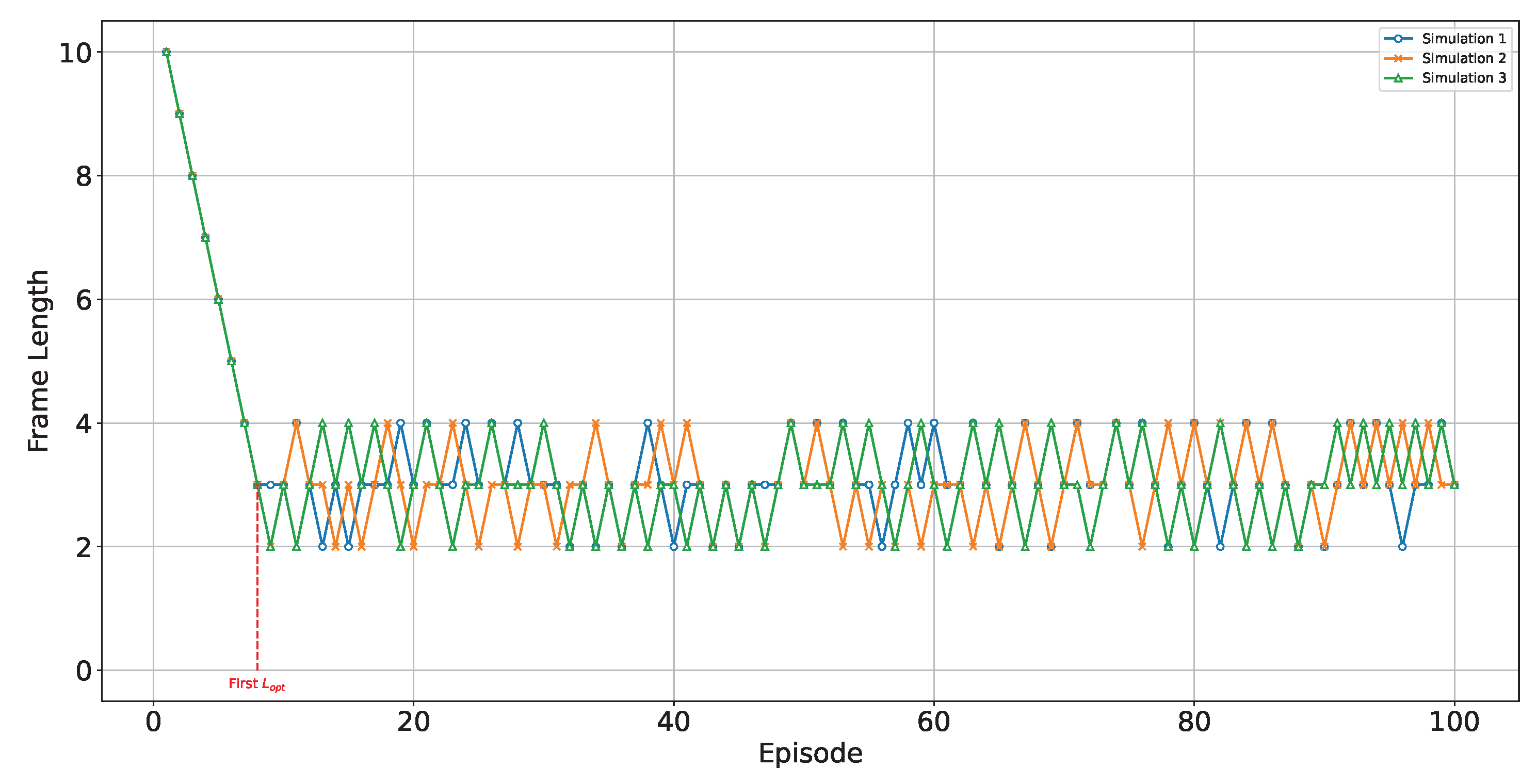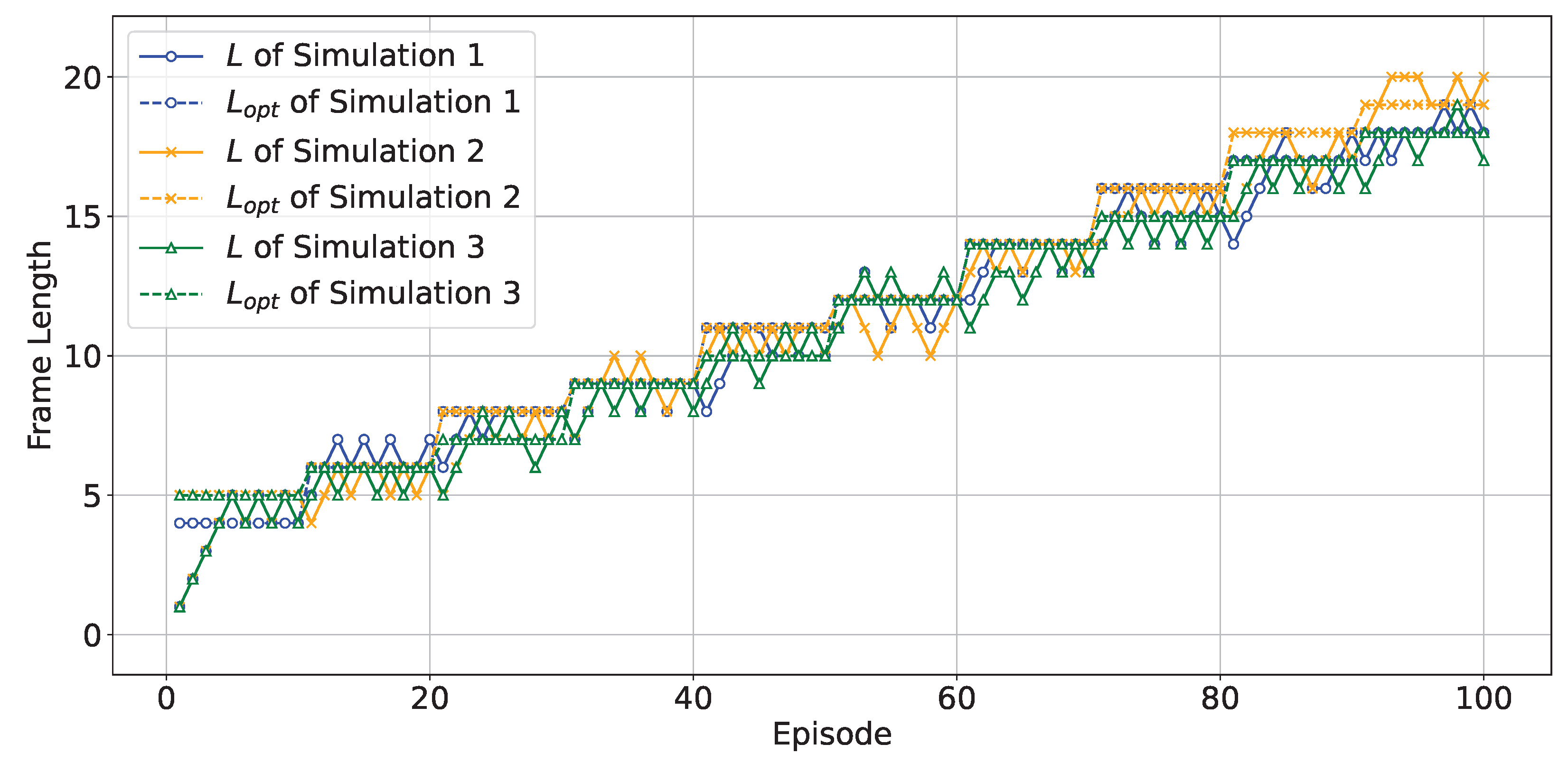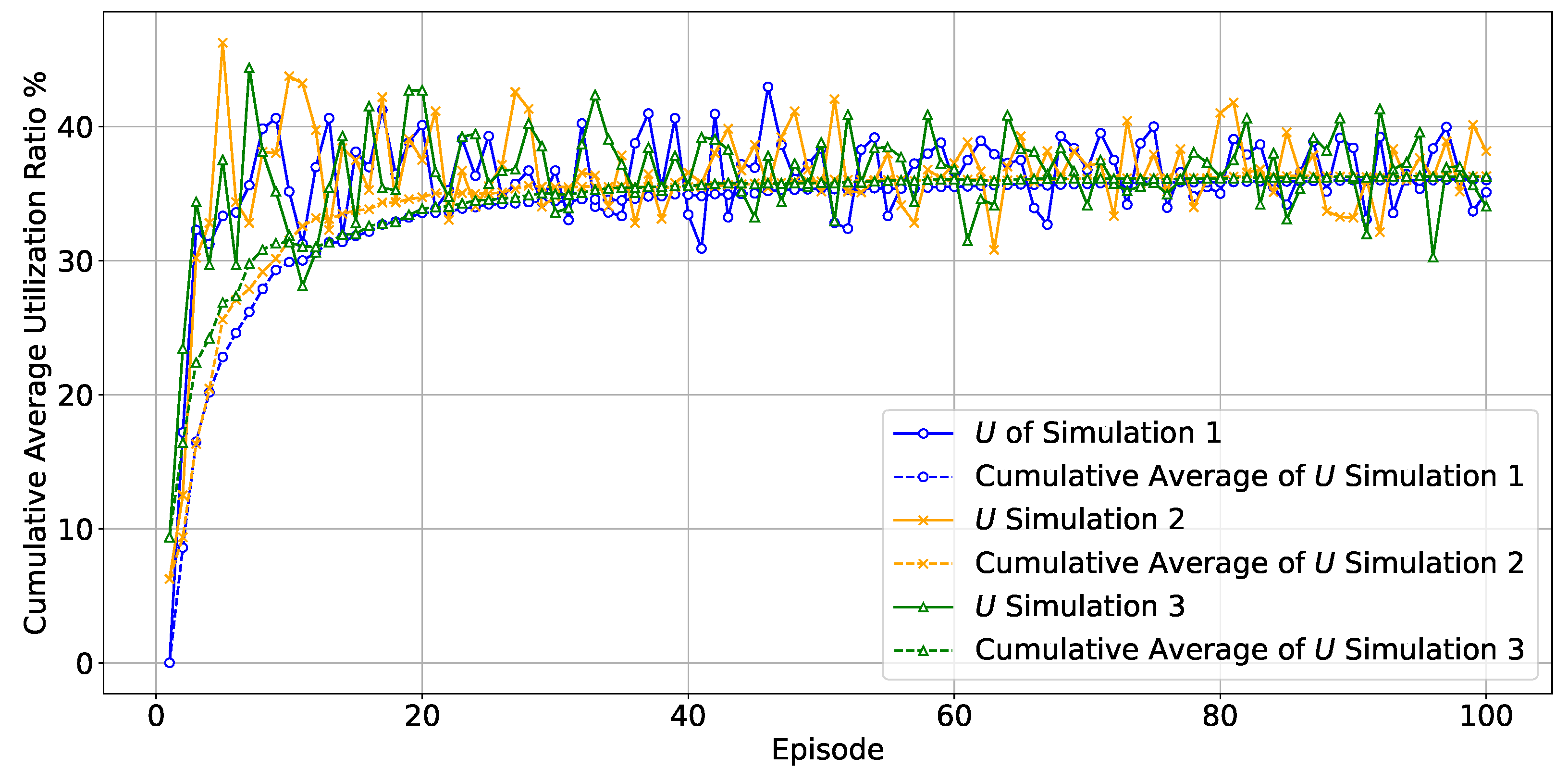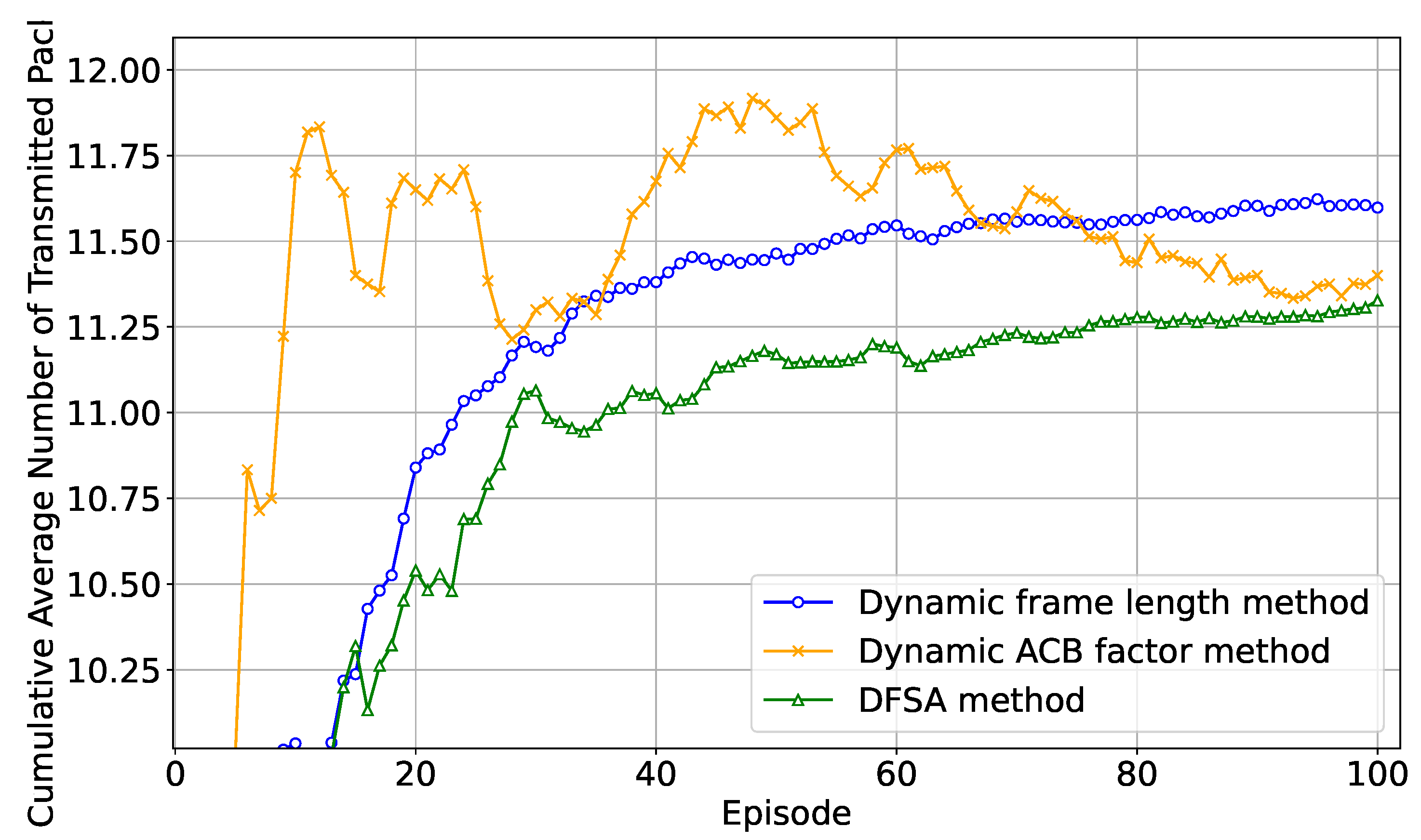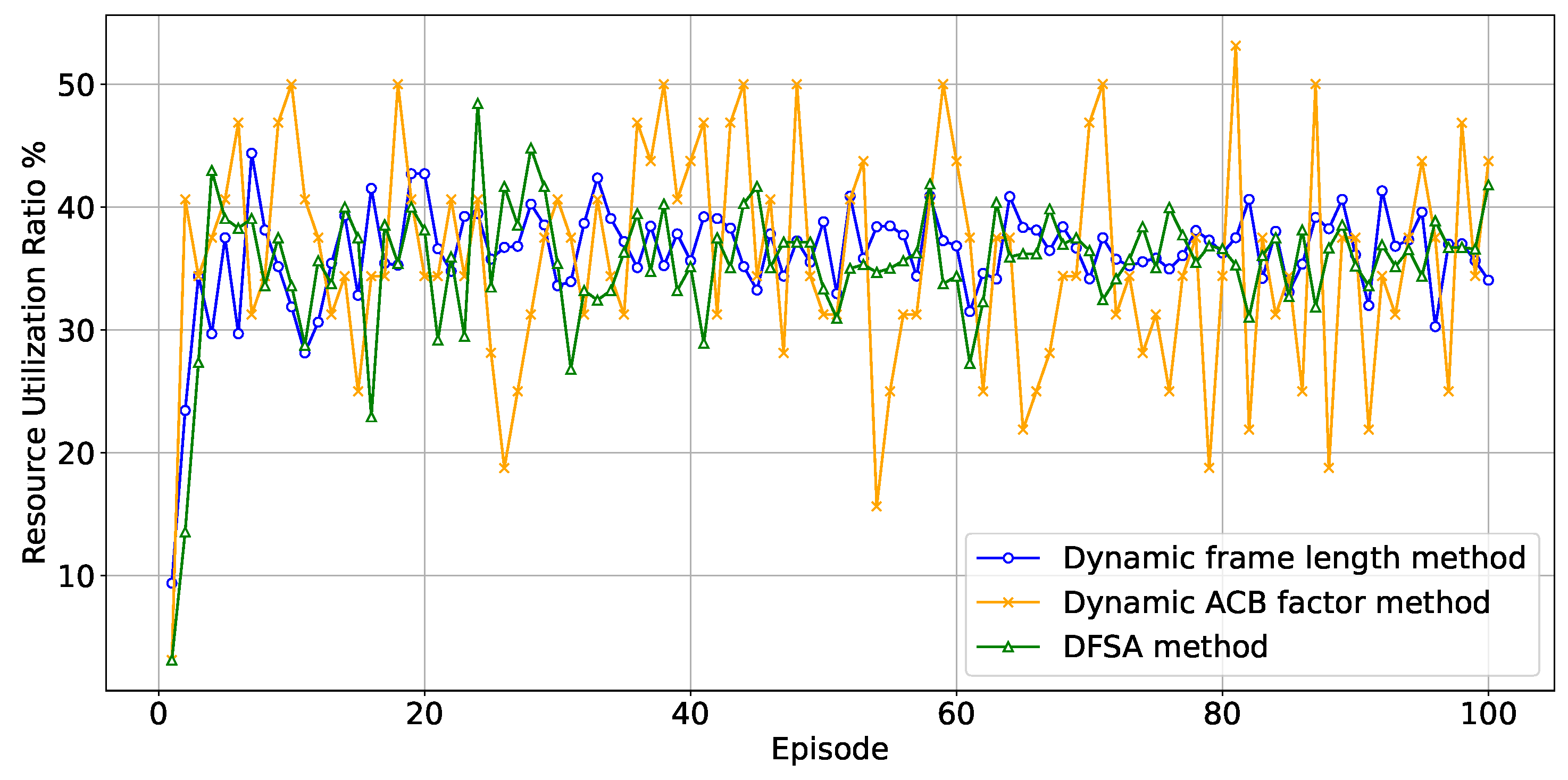1. Introduction
In the current era of rapid advancements in wireless communication technology, the explosive growth in the number of user equipment (UE) and the continuous emergence of diverse service requirements have posed unprecedented challenges to the performance and efficiency of wireless access networks. The random access process, as the initial and critical step for UEs to establish communication connections with base stations, directly influences the system’s access success ratio, latency, and overall capacity. Traditional random access mechanisms typically employ a fixed frame length design [
1]. However, this rigid model has gradually revealed numerous limitations when confronted with dynamically changing network environments and user behaviors.
In communication scenarios, the access behavior of UE exhibits a high degree of randomness and unpredictability. The number of access requests initiated by users can vary significantly across different time periods. Moreover, with the widespread deployment of Internet of Things (IoT) devices, a vast number of low-power, low-rate IoT devices are connecting to the network, further intensifying the dynamic nature and complexity of access requests. The random access mechanism with a fixed frame length fails to adapt resource allocation flexibly in response to these real-time changing access demands. As a result, it leads to issues such as increased access collision probabilities and prolonged access delays under high-load conditions, while also causing resource wastage and reducing the overall efficiency of the system during low-load periods.
To address these challenges, the concept of dynamically updating frame lengths has emerged. By monitoring information such as UE access patterns and service loads in the network, and flexibly adjusting the length of the random access frame based on this dynamic data, the system can better adapt to the ever-changing network environment. The mechanism of dynamically updating frame lengths allows for rational resource allocation according to actual access demands. During high-load periods, it can increase the frame length to provide more access opportunities and reduce collision probabilities; during low-load periods, it can shorten the frame length to minimize resource usage and enhance the overall efficiency of the system. This dynamic adjustment approach not only significantly improves the random access performance of user equipment but also optimizes the utilization of network resources, providing robust support for future wireless communication networks to meet the escalating user demands and service diversity. Therefore, in-depth research into user equipment random access technologies based on dynamically updated frame lengths holds significant theoretical importance and practical application value.
In communication systems, dynamically adjusting frame length to achieve optimal performance is crucial for maximizing throughput. Existing research has explored this problem from various perspectives:
The study in [
2] investigates a dynamic frame length selection algorithm for slot access in LTE-Advanced systems. Although it does not employ Q-learning, simulations confirm that the algorithm effectively improves access success rates, reduces access delays, and minimizes preamble retransmissions. Meanwhile, ref. [
3] presents a Q-learning-based distributed random access method to optimize the allocation of MTC devices in random access slots. Experimental results demonstrate that this approach converges reliably and maintains strong performance under varying device counts and network loads. This suggests that reinforcement learning can enhance slot allocation even with fixed frame lengths, though dynamically adjusting both frame length and slot numbers may further optimize performance in practical scenarios.
Recent advances integrate machine learning with frame length adaptation. For instance, the research in [
4] explores random access control in satellite IoT by combining Q-learning with compressed random access techniques. Here, the frame length is dynamically adjusted based on a support set estimated via compressive sensing reconstruction, ensuring stable high throughput even under heavy traffic. Similarly, a dynamic frame length adjustment (DFLA) algorithm for Wi-Fi backscatter systems is introduced in [
5], which outperforms existing Q-learning methods in collision avoidance and throughput efficiency.
Research on RFID systems also provides valuable insights. Dynamic frame length optimization and anti-collision algorithms are analyzed in [
6], highlighting that improper frame lengths (either too large or too small) degrade throughput. The research in [
7] enhances the dynamic frame-based slotted ALOHA (DFSA) algorithm with an improved tag estimation method, while ref. [
8] presents a closed-form solution for optimal frame length in FSA systems, accounting for slot duration and capture probability—critical for dense RFID networks requiring rapid tag identification.
Additional noteworthy contributions in this field include the following: ref. [
9] shows an innovative dynamic threshold selection mechanism for wake-up control systems, which shares fundamental principles with adaptive frame length adjustment methodologies. The study in [
10] provides a comprehensive analysis of the energy efficiency trade-offs in wireless sensor networks, particularly focusing on the relationship between frame length configuration and frame error rate performance. In ref. [
11], researchers developed a closed-form analytical solution for optimizing frame length in FSA systems, with special consideration given to systems with non-uniform slot durations. The study of [
12] introduces a novel hybrid approach that combines EPC Global Frame Slotted ALOHA with neural network techniques to significantly enhance RFID tag identification efficiency. Ref. [
13] shows a dynamic time-preamble table method based on the estimation of the number of UEs and compares it with the Access Class Barring (ACB) factor method, demonstrating that the proposed method better adapts to dynamic network scenarios. However, the method proposed in this paper does not employ reinforcement learning.
Q-learning has proven instrumental in mitigating communication collisions and enabling dynamic resource allocation in modern networks. Ref. [
14] presents a cooperative distributed Q-learning mechanism designed for resource-constrained machine-type communication (MTC) devices. This approach enables devices to identify unique random access (RA) slots for transmission, substantially reducing collision probabilities. The proposed system adopts a frame-based slotted ALOHA scheme, where each frame is partitioned into multiple RA slots.
Further advancing this field, the authors of [
15] introduce the FA-QL-RACH scheme, which implements distinct frame structures for Human-to-Human and Machine-to-Machine (M2M) communications. By employing Q-learning to regulate RACH access for M2M devices, the scheme achieves near collision-free performance. Meanwhile, the research in [
16] leverages Q-learning combined with Non-Orthogonal Multiple Access technology to optimize random access in IoT-enabled Satellite–Terrestrial Relay Networks. The solution dynamically allocates resources by optimizing both relay selection and available channel utilization. Multi-agent Q-learning also plays a significant role in addressing random access challenges in mMTC networks [
17]. By integrating Sparse Code Multiple Access technology with Q-learning, the system’s spectral efficiency and resource utilization can be notably enhanced [
18,
19]. While these studies do not explicitly address dynamic frame length adaptation, their underlying frameworks establish critical foundations for implementing frame length adjustment strategies. The Q-learning paradigms demonstrated in these works could be extended to incorporate dynamic frame length optimization, potentially yielding further performance enhancements in resource allocation and collision avoidance.
The performance impact of dynamic ACB parameters and dynamic frame length on random access is equivalent, with both approaches experimentally deriving an optimal preamble utilization ratio of
[
20,
21]. Traditional methods for updating random access parameters rely on estimating the number of users [
22]. After the base station broadcasts to the UE, the UEs begin competing for preambles. The base station then tallies the number of unselected preambles and those successfully utilized. However, the number of UEs is unknown to the base station. Therefore, it is necessary to first estimate the number of UEs and then update the random access-related parameters, such as the Access Class Barring parameter or frame length, based on this estimated count.
In the method proposed in this paper, we utilize reinforcement learning to adaptively determine the adjustment of frame length, enabling the system to autonomously perceive the characteristics of access traffic. By dynamically adjusting the frame length, this method enhances the utilization efficiency of preamble resources. Under high-load conditions, increasing the frame length allows for full utilization of preamble resources, whereas under low-load conditions, shortening the frame length helps avoid resource wastage. Traditional methods typically require estimating the number of UE first and then updating random access parameters based on these estimates. In contrast, the method proposed in this paper eliminates the need for complex UE number estimation by directly employing a Q-learning algorithm to dynamically adjust the frame length, thereby simplifying system design and implementation.
The structure of this paper is as follows. In
Section 1, we introduce the main methods for dynamically updating parameters in the current random access process and highlight the differences between our proposed approach and existing ones. In
Section 2, we describe the frame structure utilized in this paper and elaborate on the Q-learning-based dynamic frame length optimization algorithm. In
Section 3, we simulate the algorithm and present the performance of the Q-learning-based dynamic frame length optimization algorithm through graphical representations. Finally, in
Section 4, we summarize the Q-learning-based dynamic frame length optimization algorithm.
3. Results and Discussion
By leveraging Q-learning, we can effectively and dynamically adjust the number of time slots in a frame. According to ref. [
21], we ascertain that the optimal number of time slots in a frame, denoted as
, is given by
, where the round() function represents rounding to the nearest integer,
N signifies the number of UEs, and
M denotes the number of preambles per time slot.
In this simulation, we set the initial number of time slots in a frame to 10. The relevant parameters are shown in
Table 1. Based on Formula (
4), we can readily calculate the theoretical optimal number of time slots
when the number of UEs
and number of preambles
.
We employ Algorithm 1 to update the number of time slots in a frame, and the variation in the number of time slots, denoted as
L, is illustrated in
Figure 2.
As can be seen from
Figure 2, we recorded the changes in frame length across three simulation runs. After several rounds of updates, the number of time slots in a frame rapidly converges to the optimal value, and subsequently fluctuates around this optimal value. This indicates that the time slot quantity updating method incorporating Q-learning can swiftly and dynamically adjust the number of time slots in a frame to the optimal level.
Next, we delve into examining how many rounds it takes for the Q-learning-based dynamic frame length update algorithm to reach the optimal frame length, given varying numbers of users. For this exploration, we set the initial number of time slots to 1. The relevant parameters are shown in
Table 2.
We set different numbers of users and conducted simulations over 100 rounds to verify whether this method can adjust the frame length to the optimal value under varying numbers of user devices. After the simulations, we recorded the corresponding theoretical optimal frame lengths
as well as the average frame lengths
L achieved by Algorithm 1 over the final 10 rounds in
Table 3.
It is evident from the data presented in
Table 3 that regardless of the disparity between the initial frame length and the theoretically optimal frame length, the Q-learning-based dynamic frame length optimization algorithm is capable of updating the frame length to a value close to the theoretically optimal one.
In practical scenarios of random access, the number of UEs is not constant but dynamically changing. To investigate whether the Q-learning-based dynamic frame length optimization algorithm can effectively adapt to such fluctuating numbers of UEs, we introduce the random addition of a certain number of UEs every 10 rounds. The number of newly added UEs follows a Poisson distribution.
We set
, meaning that a certain number of UEs are added randomly every 10 rounds, with the number of newly added UEs following a Poisson distribution with a parameter of 50. Under such circumstances, after utilizing the Q-learning-based dynamic frame length optimization algorithm, the variations in the actual frame length and the theoretically optimal frame length are depicted in
Figure 3.
As shown in
Figure 3, we recorded the changes in both the actual and theoretically optimal frame lengths across three simulation runs. As the number of user equipment (UE) increases, the theoretically optimal frame length also rises continuously. Meanwhile, under the influence of the Q-learning-based dynamic frame length optimization algorithm, the actual frame length keeps increasing and fluctuates around the theoretical optimal frame length. This indicates that even when the number of user equipment changes dynamically, the Q-learning-based dynamic frame length optimization algorithm can still ensure that the frame length is updated to the theoretical optimal value. We can observe little lag or overshoot in the figure. A relatively high learning rate may accelerate parameter updates, but if the step size is excessively large, it can cause the system to oscillate near the optimal solution, manifesting as delays in decision making or state adjustments. Additionally, it may result in overly aggressive single-update steps that surpass the optimal value, necessitating subsequent reverse adjustments to correct, thereby inducing fluctuations.
Meanwhile, the resource utilization ratio
U of preamble resources, along with its cumulative average utilization ratio, is depicted in
Figure 4.
As can be observed from
Figure 4, we recorded the preamble resource utilization data from three simulation runs, along with their corresponding cumulative average resource utilization rates. Even with a continuous increase in the number of UEs, under the Q-learning-based dynamic frame length optimization algorithm, the preamble resource utilization ratio gradually stabilizes, and the cumulative average utilization ratio also converges to
. From the figure, it can be observed that during the initial stage of the algorithm, due to the uncertainty of initial conditions, there are significant fluctuations in resource utilization and its cumulative average, reflecting the trade-off between exploration and exploitation. As iterations increase, the algorithm learns better strategies, leading to a reduction in fluctuations and the system approaching stability. The learning rate determines the step size for updating values in the Q-table; a larger learning rate accelerates convergence but may cause oscillations or miss the optimal solution, reducing stability, while a smaller learning rate results in slower convergence but greater precision, enhancing stability. A large learning rate speeds up convergence initially but may lead to getting stuck in local optima later on; a small learning rate ensures precision but has a prolonged convergence process. The discount factor reflects the algorithm’s emphasis on future rewards; a high discount factor enhances long-term stability but may be overly conservative, overlooking short-term opportunities, whereas a low discount factor focuses on immediate rewards, offering better short-term adaptability but potentially compromising long-term stability. A high discount factor slows down initial convergence as it requires more time to evaluate long-term rewards, but once the long-term optimal strategy is found, convergence can accelerate, with subsequent decisions becoming more stable and consistent. Conversely, a low discount factor may lead to faster short-term convergence, but the solution may be suboptimal, resulting in unstable long-term performance.
Under the same scenario of an increase in the number of UEs as described above, we compared the successful selected preamble ratio between the dynamic frame length optimization method based on Q-learning and the dynamic ACB factor method and DFSA (Dynamic Frame Slotted ALOHA) method based on probability model estimation. Comparisons of cumulative average throughput and the cumulative resource utilization ratio are presented in
Figure 5 and
Figure 6.
Analyzing the data presented in the figures above, we observe that the cumulative average throughput of the dynamic frame length optimization method based on Q-learning slightly surpasses that of the dynamic ACB factor method and DFSA method. After multiple rounds of simulation comparisons, we selected a set of representative figures. We calculated that the standard deviation of the dynamic frame length method is , while that of the dynamic ACB factor method is and that of the DFSA method is . The standard deviation of the dynamic frame length method is only half of that of the dynamic ACB factor method and close to that of the DFSA method, indicating that the dynamic frame length method exhibits greater stability. When compared to the dynamic ACB factor method, which relies on a probability model for estimating the number of user equipment, the dynamic frame length method ensures a more consistent success ratio for the random access of user equipment. The core reason lies in Q-learning’s inherent adaptive decision-making capability. By continuously monitoring the occupancy status of preambles in the current frame, Q-learning dynamically adjusts the length of the subsequent frame. In contrast, the ACB method and DFSA method necessitate an initial estimation of the current number of users, followed by the calculation of the blocking probability based on this estimate. However, real-time estimation of the user count is susceptible to errors, resulting in a delay in ACB factor updates relative to actual load variations and consequently causing fluctuations in resource utilization.
4. Conclusions and Future Work
In this study, we proposed a dynamic frame length optimization method based on Q-learning, which aims to address the issues of channel resource competition and preamble collisions during the random access process in MTC systems. By leveraging reinforcement learning algorithms to autonomously perceive access traffic characteristics and dynamically adjust frame length parameters, this method has abandoned traditional approaches such as Access Class Barring, which employs maximum likelihood estimation algorithms to estimate the number of UEs. Instead, it utilizes Q-learning to directly update and adjust the frame length. We successfully achieved frame length optimization without relying on estimates of the number of UEs, significantly enhancing random access performance and preamble resource utilization. With the rapid development of IoT and 5G technologies, the random access problem in MTC systems has become increasingly prominent. The dynamic frame length optimization method proposed in this study effectively alleviated access congestion, improved system capacity, enhanced user experience, and has great potential for future applications in the field of communications.
As future work, we will focus on the performance of this dynamic frame length optimization method in complex scenarios such as asynchronous arrivals and delayed feedback. In doing so, through the systematic exploration and analysis of these complex scenarios, we aim to comprehensively uncover their underlying patterns and potential impacts. Subsequently, we will meticulously refine the existing research findings. In this way, we can effectively enhance the practicality and universality of the method, enabling it to exert a positive influence in a broader range of fields and real-world scenarios.
